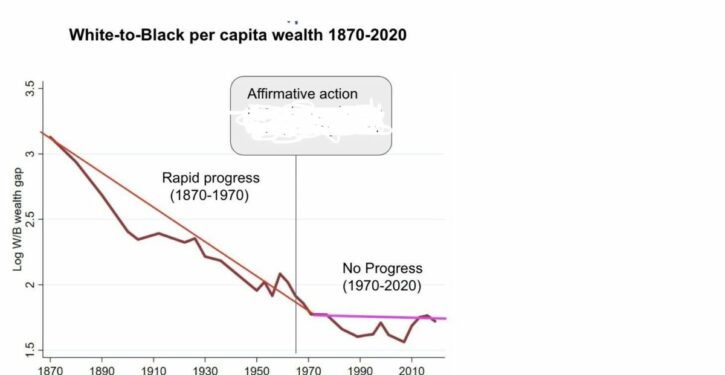
Last week, the Supreme Court found that two universities had engaged in illegal racial discrimination in admissions, against Asian and white applicants. The court’s ruling in Students for Fair Admissions v. Harvard was not unanimous — the Court’s three progressive justices dissented, in an opinion that would in effect allow colleges to use race in admissions forever, in hopes that doing so would somehow reduce racial gaps in health, wealth, and well-being. But these gaps largely aren’t the result of discrimination. Racial gaps exist everywhere on Earth, not just in nations with a legacy of race-based slavery or segregation, as the black economists Thomas Sowell and Walter Williams have noted. Moreover, using race in college admissions won’t do anything about racial gaps in well-being. Indeed, as Justice Thomas noted in his concurring opinion, applicants admitted based on their race get worse grades than those admitted based on merit, and to avoid flunking out, black students sometimes shift from demanding majors to easier majors. That can reduce black students’ future earnings and their ability to contribute to society.
Indeed, the wealth gap between blacks and whites shrank faster before affirmative action existed than afterwards, as you can see from the graph that accompanies this article. The first major affirmative action program began in 1970, when the Labor Department issued Order No.4, authorizing racial goals and timetables to increase utilization of minorities by federal contractors. And right around 1970, blacks started making less progress than before, as welfare programs created by Lyndon Johnson’s Great Society began weakening the family, and the black family most of all. As Austin Padgett notes, “After the civil war, black per capita wealth increased 5% every decade relative to white people, all the way up to 1970 when the progress stopped. Had that rate continued past the 70’s we would have seen racial wealth parity by the year 2040. But something happened in the 70’s… The great society programs began to take effect.” The black columnist Jason Riley observes that the “destructive legacy of the Great Society” was that “government subsidies for antisocial behavior stalled decades worth of black progress.”
Ironically, noted Padgett, “Black people made more economic progress under intense racism than under an expanded progressive government. Black people don’t need white saviors, they need freedom just like everyone else. We don’t need affirmative action to solve past inequalities. It isn’t racism that is responsible for the halting of relative progress in the last 50 years, since racism was significantly more present before the stagnation.”
Moreover, affirmative action in college admissions is simply irrelevant to most black people. As Jane Coaston of the New York Times notes, “most colleges and universities don’t use affirmative action because most schools accept pretty much everyone who applies. Selective universities are a small slice of what ‘college’ is in America.”
But according to the dissent by three progressive justices, using race in college admissions is the “only” way “possible” to somehow get rid of gaps between minorities and whites in “health, wealth, and well-being,” and blacks must be given a racial preference in college admissions until those gaps disappear. That claim ignores the fact that blacks were gradually closing the gap with whites before any affirmative action for blacks existed, indeed, at a faster rate than today.
In their dissent, the three progressive justices made false claims about health disparities between blacks and whites, inaccurately claiming that black babies are much less likely to survive with a white physician (a claim debunked in the National Review, Daily Signal, and other sources), and falsely implying that racial minorities in general have shorter life spans than whites (in fact, Hispanics and Asians typically live longer than whites).
The three progressive justices simply ignored the plain language of the civil-rights laws, which ban racial discrimination against anyone, even whites and Asians. Racial discrimination in college admissions violates Title VI of the Civil Rights Act, which states that “No person in the United States shall, on the ground of race, color, or national origin, be excluded from participation in, be denied the benefits of, or be subjected to discrimination under any program or activity receiving Federal financial assistance.
Justice Ketanji Brown Jackson claimed in her dissent, which was joined by Justices Elena Kagan and Sonia Sotomayor, “race-linked health inequities pervad[e] nearly every index of human health” resulting “in an overall reduced life expectancy for racial and ethnic minorities that cannot be explained by genetics.”
That is bunk. In reality, Hispanics live longer than whites on average, and Asians live significantly longer than whites. Whites, in turn, live longer than blacks. If you combine blacks and Hispanics into one minority category, then minorities’ life span is close to whites. If you add Asians into the minority category, minorities may actually live longer than whites.
But Justice Jackson’s dissent justified racial preferences in college admissions as a way of getting rid of gaps in things like life expectancy — even though Hispanics suffer no gap in life expectancy, but rather live longer than the average American, yet they often receive a racial preference in admissions to elite colleges like Harvard. As the Supreme Court noted, “in the Harvard admissions process,” “a significant percentage ‘of all admitted African American and Hispanic applicants” are admitted because of their race.
Yet Justice Jackson wrote that “only” because of racial preferences are “minorities…doing better”:
Gulf-sized race-based gaps exist with respect to the health, wealth, and well-being of American citizens. They were created in the distant past, but have indisputably been passed down to the present day through the generations…..Today’s decision will undoubtedly extend the duration of our country’s need for such race consciousness, because the justification for ad missions programs that account for race is inseparable from the race-linked gaps in health, wealth, and well-being that still exist in our society (the closure of which today’s decision will forestall)….
while the gaps are stubborn and pernicious, Black people, and other minorities, have generally been doing better. But those improvements have only been made possible because institutions like UNC have been willing to grapple forthrightly with the burdens of history.
If colleges can use race in admissions because “race-based gaps exist,” then they will be able to use race forever, because race-based gaps exist in every country on Earth, for reasons unrelated to racism. They exist even in countries where people were never enslaved based on their race, and segregation never existed. Racial disparities exist everywhere in the world, often for non-racist reasons, notes the black economist Thomas Sowell in his book Discrimination and Disparities.
Racial gaps are not due to discrimination: Hispanics live three years longer than whites, on average, even though doctors don’t discriminate in their favor. Asians make more money than whites, on average. And while blacks make less money than whites, on average, African immigrants to America make more money than whites. To get rid of racial “disparities,” the government would have to wield totalitarian power, notes black economist Glenn Loury.
In their dissent advocating race-based affirmative action, the Supreme Court’s three progressive justices cited an obviously false statistic about the death rates of black babies. They gullibly cited the statistic, even though it was mathematically almost impossible, and had been debunked months before by people like Ted Frank, a member of the Supreme Court bar.
As the Daily Signal explains:
In her dissenting opinion to the Supreme Court’s decision to strike down racial preferences in university admissions, Justice Ketanji Brown Jackson managed to pull off a trifecta: She was factually incorrect in describing the results of a study that should not be believed, which wouldn’t provide practical support for her argument even if it were accurate and credible.
Jackson claimed that racial preferences were essential in admission to medical schools because more black doctors were needed to improve health outcomes for black patients.
Specifically, she wrote, “For high-risk black newborns, having a black physician more than doubles the likelihood that the baby will live, and not die.” That claim was taken from an amicus brief filed by the Association of American Medical Colleges, which in turn was referencing a study that appeared in the Proceedings of the National Academy of Sciences.
First, the study does not claim to find a doubling in survival rates for black newborns who have a black attending doctor. Instead, in its most fully specified model, it reports that 99.6839% of black babies born with a black attending physician survived compared with 99.5549% of black babies born with white attending physicians, a difference of 0.129%.
The survival rate of 99.6839% is not double 99.5549%.
The claim that survival rates for black newborns double when they have black physicians is just plain false. The fact that neither the Association of American Medical Colleges nor Jackson’s clerks could read and properly understand a medical study is an alarming indication for the current state of both medical and legal education.
Second, even if the results of the Proceedings of the National Academy of Sciences study were accurately described, they should not be believed. The study’s comparison of death rates for newborns who have doctors of different races does not take into account the fact that black newborns have a greater likelihood of serious medical complications and the attending physicians assigned to treat those more challenging cases are likely to be white.
For example, the study does control for whether newborns are low weight (less than 2,500 grams), but does not control for whether they are very low weight (less than 1,500 grams). Black newborns are almost three times as likely as white newborns to weigh less than 1,500 grams.
Doctors assigned to treat very low-weight babies are more likely to be specialists, rather than regular pediatricians or family practitioners. Black doctors are significantly less likely to be found in those specialized fields.
More than 5% of pediatricians or family practice physicians are black, compared with 3.8% of neonatologists and pediatric cardiologists, and 1.8% of pediatric surgeons.
Rather than demonstrating the protective benefits of black newborns having black doctors, the Proceedings of the National Academy of Sciences study only documents that black newborns are more likely to have severe issues that increase their risk of infant mortality, and those severe cases are more likely to have white attending physicians because white doctors are more prevalent in the specialized fields that treat those complications.
The study provides no convincing evidence on whether black newborns with identical conditions would fare better, worse, or no differently with a black or white doctor.



